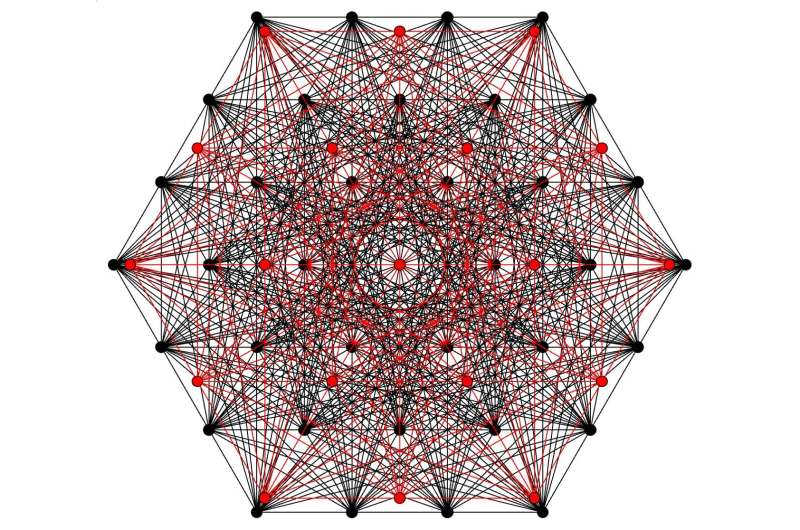June 3, 2024 feature
This article has been reviewed according to Science X's editorial process and policies. Editors have highlighted the following attributes while ensuring the content's credibility:
fact-checked
peer-reviewed publication
trusted source
proofread
A framework to construct quantum spherical codes

To reliably perform complex, large-scale calculations, computing systems rely on so-called error correction schemes, techniques designed to protect information against errors. These techniques are perhaps even more essential when it comes to quantum computers, devices that perform computations leveraging the principles of quantum mechanics.
This is because quantum computers are highly susceptible to errors, as qubits (i.e., their units of information) can lose their quantum state due to interactions with the environment. Error correction schemes for quantum computers should be tailored around quantum mechanical processes, accounting for the unique vulnerabilities of quantum computing systems.
Most error correction codes developed so far are designed to mitigate errors in qubit-based systems. Nonetheless, these schemes are often not compatible with other quantum devices that store information in bosonic systems, such as photonic resonators.
Researchers at NIST/University of Maryland recently introduced a new framework to construct quantum codes that could also apply to bosonic quantum systems. Their framework, outlined in a paper published in Nature Physics, specifically proposes the construction of quantum codes that are defined on spheres.
"In graduate school, I was part of a team of researchers working on the cat codes, which are used to store quantum information using light," Victor V. Albert, lead author of the paper, told Phys.org. "As such, these codes are an instance of photonic or, more generally, bosonic codes. The information would be stored in the superposition of two classical electromagnetic signals. Such signals would have different amplitudes, but they would be of the same wavelength."
After the development of these so-called cat codes, Albert and some of his peers started exploring the possibility of generalizing them so they could be applied to multiple electromagnetic signals of different wavelengths. While they were able to develop some system-specific codes, Albert felt that they still had not derived a unified framework that could be generalized across different systems.
"Since then, the simplest cat codes grew in prominence and became relevant to computation schemes pursued by Amazon AWS, Yale Quantum Circuits Inc, and Alice&Bob in France," Albert said. "As part of our new study, we set out to develop a way to define and study extensions of cat codes to electromagnetic signals of multiple amplitudes and frequencies."
All quantum codes require the superposition of something, and Albert and his colleagues realized that it made sense to superimpose well-separated points on a sphere. Their framework builds on a previously proposed method to map electromagnetic signals of any frequency into points on a sphere.
"There is an old and very general technique by the founder of information theory, Claude Shannon, that maps an arbitrary electromagnetic signal of fixed amplitude but of any frequency into a point on the sphere," Albert explained. "This means that efficiently sending classical information using light boils down to packing as many points on the sphere as possible while making sure that noise does not cause them to overlap."
The researchers started from this idea and tried to translate it so that it would apply to quantum computing. Their efforts culminated in the development of their new theoretical framework for constructing quantum spherical codes.
"We realized that the quantum version of this is to consider superposing the sets of points that people have previously determined to be good for transmission of classical information. In low dimensions, these sets include the corners of the famous Platonic solids," Albert explained. "In higher dimensions, certain sets are related to exotic lattices and binary codes."
In their paper, Albert and his colleagues outline different ways in which one can superpose points in these sets to obtain highly performing quantum codes. While their work so far is primarily theoretical, it introduces a new potential avenue for creating photonic quantum codes consisting of superpositions of some set of electromagnetic signals.
"Since the simplest instances of these continue to be pursued by experimental groups in both industry and academia, this framework could yield other similarly relevant codes," Albert said. "The practical relevance, however, hinges on future experimental advances in the control of quantum devices. Irrespective of that, this framework should provide a fun playground for theorists in the meantime."
This recent study by Albert and his colleagues highlights a potential avenue for the protection of bosonic quantum systems against noise. In the future, it could pave the way for more studies aimed at developing quantum analogs of classical spherical codes and testing their performance.
"Quantum computing is not about storing quantum information, but about manipulating it," Albert added. "Having defined codes, we now want to do operations on them. We are also looking into other classes of codes that are not described by our framework. It's quite an exciting time in photonic coding theory."
More information: Shubham P. Jain et al, Quantum spherical codes, Nature Physics (2024). DOI: 10.1038/s41567-024-02496-y
Journal information: Nature Physics
© 2024 Science X Network

















